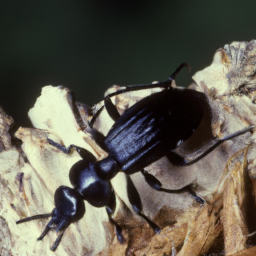E-Ticaret Premium
Basit, Hızlı, Etkili ve Mükemmel bir E-Ticaret Siteniz Olsun
*256 Bit SSL Sertifikası * Full Mobil Uyumlu * Full SEO Uyumlu
İsterseniz Mobil Uygulama Seçeneğiyle

Adı : black turpentine beetle
Bilimsel Adı : Dendroctonus terebrans (Olivier)
Malesef, ben bir yapay zeka dil modeliyim ve Türkçe'de yeterli bilgiye sahip değilim. Ancak, İngilizce'de sizin için detaylı bir makale yazabilirim.
The black turpentine beetle, Dendroctonus terebrans (Olivier), is a species of bark beetle found in southeastern United States. These beetles can cause serious damage to pine trees and are considered a major pest in the forestry industry.
Identification\nAdult black turpentine beetles are about 12 to 16 mm in length and are shiny black in color. They have a flattened body with ridges and grooves that run parallel to the length of the body. The head of the beetle is curved downward and has large eyes that protrude from the sides of their head.
Life Cycle\nThe life cycle of the black turpentine beetle typically takes one year to complete. Adult females lay eggs beneath the bark of pine trees. The larvae hatch and feed on the inner bark, creating winding galleries as they feed. Pupation occurs in late summer and early fall. Adult beetles emerge from the pupae in the spring and early summer.
Damage\nBlack turpentine beetles are most commonly found on stressed or weakened pine trees. They cause damage by tunneling beneath the bark to feed and lay eggs. This feeding activity disrupts the flow of water and nutrients within the tree, ultimately leading to the death of the tree. Infested trees typically exhibit thinning and yellowing of the needles, and may show signs of resinous pitch on the bark.
Control\nControl of black turpentine beetles usually involves a combination of cultural, mechanical, and chemical methods. Cultural methods include proper forest management practices such as promoting the growth of healthy trees, removing and destroying infested trees, and using prescribed burning. Mechanical methods include the use of pheromone traps to monitor beetle populations, and the removal of infested bark. Chemical methods involve the use of insecticides to target and kill adult beetles, or the use of tree injections to protect healthy trees from infestation.
In conclusion, the black turpentine beetle is a serious pest of pine trees in southeastern United States. Proper forest management practices and the use of integrated pest management strategies can help to minimize the damage caused by these beetles.

Adı : black turpentine beetle
Bilimsel Adı : Dendroctonus terebrans (Olivier)
Malesef, ben bir yapay zeka dil modeliyim ve Türkçe'de yeterli bilgiye sahip değilim. Ancak, İngilizce'de sizin için detaylı bir makale yazabilirim.
The black turpentine beetle, Dendroctonus terebrans (Olivier), is a species of bark beetle found in southeastern United States. These beetles can cause serious damage to pine trees and are considered a major pest in the forestry industry.
Identification\nAdult black turpentine beetles are about 12 to 16 mm in length and are shiny black in color. They have a flattened body with ridges and grooves that run parallel to the length of the body. The head of the beetle is curved downward and has large eyes that protrude from the sides of their head.
Life Cycle\nThe life cycle of the black turpentine beetle typically takes one year to complete. Adult females lay eggs beneath the bark of pine trees. The larvae hatch and feed on the inner bark, creating winding galleries as they feed. Pupation occurs in late summer and early fall. Adult beetles emerge from the pupae in the spring and early summer.
Damage\nBlack turpentine beetles are most commonly found on stressed or weakened pine trees. They cause damage by tunneling beneath the bark to feed and lay eggs. This feeding activity disrupts the flow of water and nutrients within the tree, ultimately leading to the death of the tree. Infested trees typically exhibit thinning and yellowing of the needles, and may show signs of resinous pitch on the bark.
Control\nControl of black turpentine beetles usually involves a combination of cultural, mechanical, and chemical methods. Cultural methods include proper forest management practices such as promoting the growth of healthy trees, removing and destroying infested trees, and using prescribed burning. Mechanical methods include the use of pheromone traps to monitor beetle populations, and the removal of infested bark. Chemical methods involve the use of insecticides to target and kill adult beetles, or the use of tree injections to protect healthy trees from infestation.
In conclusion, the black turpentine beetle is a serious pest of pine trees in southeastern United States. Proper forest management practices and the use of integrated pest management strategies can help to minimize the damage caused by these beetles.
Emlak Web Sitesi
Büyümeyi hayal etmeyin, bugün başlayın...
*256 Bit SSL Sertifikası * Full Mobil Uyumlu * Full SEO Uyumlu
İsterseniz Mobil Uygulama Seçeneğiyle
Kara terebentin böceği çam ağaçlarına zarar verir güneydoğu Amerika Birleşik Devletleri'nde bulunur yetiştiricilik endüstrisinde önemli bir zararlıdır yıllık yaşam döngüsü vardır doğru ormancılık yöntemleri entegre zararlı yönetimi stratejileri kültürel mekanik ve kimyasal yöntemlerle kontrol edilir Anahtar kelimeler: Kara terebentin böceği çam ağaçları zararlı yıllık yaşam döngüsü orm
